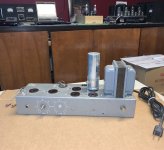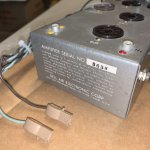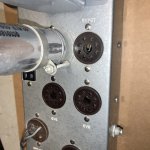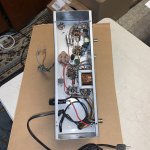i will be needing to source tubes for this amp and clearly this amp calls for 6J5 and 6SL7 preamp tubes- do the replacement tubes have to be 8 pin?
and as this amp has a "can capacitor" does removing this remove residual voltage stored in the amp?
and as this amp has a "can capacitor" does removing this remove residual voltage stored in the amp?
i will be needing to source tubes for this amp and clearly this amp calls for 6J5 and 6SL7 preamp tubes- do the replacement tubes have to be 8 pin?
and as this amp has a "can capacitor" does removing this remove residual voltage stored in the amp?
Replacement tubes have to fit the sockets.
There won't be any stored charge. It has dissipated long ago.
Last edited:
Replacing the tubes with the proper ones is of course the best idea, major surgery would be required to change sockets for noval tubes of similar specification, and there aren't really direct replacements for all of them in noval. (9-pin)
Here's some links to the stock tubes, of course there are other sources.
https://www.tubedepot.com/t/tubes/power-tubes/6v6
https://www.tubedepot.com/t/tubes/preamp-tubes/6sl7
https://www.amplifiedparts.com/products/vacuum-tube-6j5-triode-medium-mu
https://www.tubedepot.com/t/tubes/rectifier-tubes/5y3-5z3
The capacitor is very old and its advisable to replace it.
Here's some links to the stock tubes, of course there are other sources.
https://www.tubedepot.com/t/tubes/power-tubes/6v6
https://www.tubedepot.com/t/tubes/preamp-tubes/6sl7
https://www.amplifiedparts.com/products/vacuum-tube-6j5-triode-medium-mu
https://www.tubedepot.com/t/tubes/rectifier-tubes/5y3-5z3
The capacitor is very old and its advisable to replace it.
I had great support from Antique Electronic Supply when restoring an old Ampeg Gemini amp. Always use them when buying tubes now.
https://www.tubesandmore.com/
Lots of 6SL7s to choose from.
Should have some multi-section caps as well.
https://www.tubesandmore.com/
Lots of 6SL7s to choose from.
Should have some multi-section caps as well.
Last edited:
Be patient, we can be blunt and sharp! But we love is to help! You seem new to DIY culture.
Removing the cap just means it needs another cap to replace it. Form factor is unimportant to the electrons, but of great importance to aesthetics.
Still don't really know what you are after.
Removing the cap just means it needs another cap to replace it. Form factor is unimportant to the electrons, but of great importance to aesthetics.
Still don't really know what you are after.
here they are, plenty of mallory style multi-section caps by CE manufacturing:
https://www.tubesandmore.com/products/capacitors?filters=2341a2356
https://www.tubesandmore.com/products/capacitors?filters=2341a2356
Very clean. If it needs a new cap, get the right one, otherwise leave the old one and hide the new ones inside the chassis.
You'll definitely want to read thru this thread I just found. It appears to be that same amp: https://www.tdpri.com/threads/bell-air-mystery-deluxe.767062/i will be needing to source tubes for this amp and clearly this amp calls for 6J5 and 6SL7 preamp tubes- do the replacement tubes have to be 8 pin?
and as this amp has a "can capacitor" does removing this remove residual voltage stored in the amp?
Take note that the main can capacitor has an octal socket. This will be virtually impossible to find as a "new" cap.
I suggest you get some local help to work on this amp.
jeff
That's the first time I've seen that. Not cool for finding a replacement but very cool for implementation.Take note that the main can capacitor has an octal socket. This will be virtually impossible to find as a "new" cap.
i need to rephrase my question- while i perform other work- upgrading to a grounded plug, adding an indicator lamp and possibly replacing the tone control pot- will temporarily pulling the can cap remove any latent voltage.Be patient, we can be blunt and sharp! But we love is to help! You seem new to DIY culture.
Removing the cap just means it needs another cap to replace it. Form factor is unimportant to the electrons, but of great importance to aesthetics.
Still don't really know what you are after.
i guess my question should have been is are all 6J5 and 6SL7 tubes the same pin wise. that is are all 6J5 the same, and likewise the 6SL7.Replacing the tubes with the proper ones is of course the best idea, major surgery would be required to change sockets for noval tubes of similar specification, and there aren't really direct replacements for all of them in noval. (9-pin)
Here's some links to the stock tubes, of course there are other sources.
https://www.tubedepot.com/t/tubes/power-tubes/6v6
https://www.tubedepot.com/t/tubes/preamp-tubes/6sl7
https://www.amplifiedparts.com/products/vacuum-tube-6j5-triode-medium-mu
https://www.tubedepot.com/t/tubes/rectifier-tubes/5y3-5z3
The capacitor is very old and its advisable to replace it.
i figured the cap might need to be replaced- this amp had an 1/4" input added to the front panel so unsure if the last owner may have replaced any components as well.
Yes, you replace like for like. There may be subtle differences between different manufactures.that is are all 6J5 the same, and likewise the 6SL7.
jeff
No. If you power it on and then shut it down, the cap can remain charged. Simply pulling it from the chassis will not discharge it, you need to drain it.will temporarily pulling the can cap remove any latent voltage.
Also, in case it’s helpful to state, working on the circuit with a charged cap is likely to damage any soldering equipment.
It doesn’t look like any of the other components were touched and, if they were, it was a while ago.
I was unable to log in anywhere to see the schematic of the amplifier.
Until I am corrected by one of you, I will assume there is no Bleeder Resistor to discharge the B+ capacitor(s).
Safety First!
What? . . . No Bleeder Resistor?
Prevent the "Surviving Spouse Syndrome"
Install a proper B+ bleeder resistor.
Just my $0.02
Have Fun with the amplifier!
Until I am corrected by one of you, I will assume there is no Bleeder Resistor to discharge the B+ capacitor(s).
Safety First!
What? . . . No Bleeder Resistor?
Prevent the "Surviving Spouse Syndrome"
Install a proper B+ bleeder resistor.
Just my $0.02
Have Fun with the amplifier!
- Home
- Amplifiers
- Tubes / Valves
- new to site. longtime hi-fi and tube guitar amp aficionado with questions on a vintage tube amp




